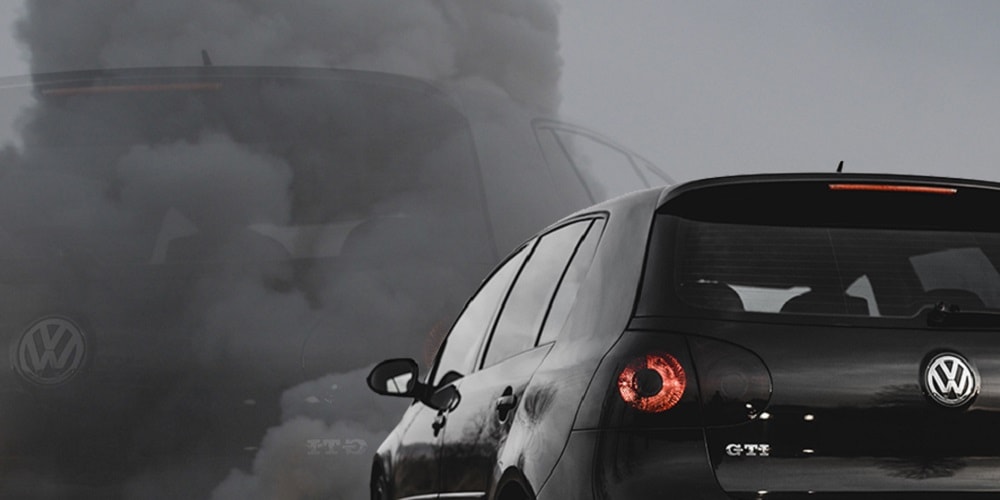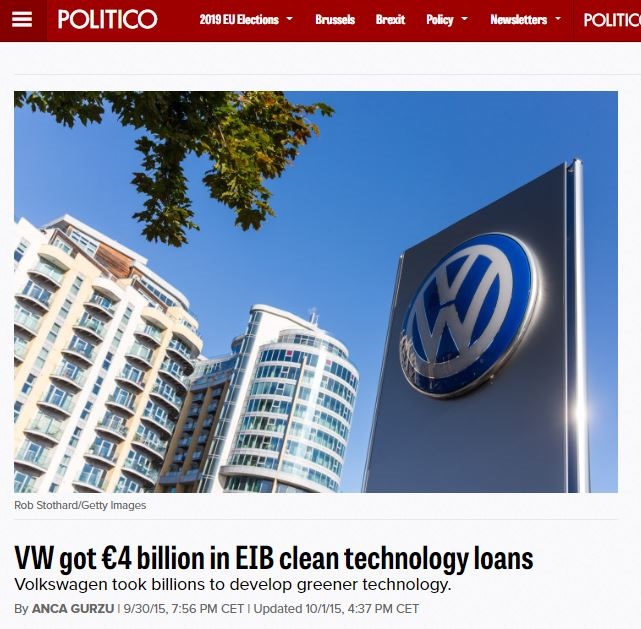Long overdue, and short on content, a compact version of the investigation report on the role of EIB money in the Dieselgate scandal affirms Bankwatch’s revelations that helped trigger this important inquiry. But in its aftermath, there is little to suggest that the EU’s bank has done anything to ensure that the public money it manages will not be misused.
Ido Liven, Media officer | 7 March 2019

Nearly three and a half years after Bankwatch first raised concerns that millions of euros from the European Investment Bank (EIB) were involved in the Dieselgate scandal, a recently released summary report of an investigation by OLAF, the European Anti-Fraud Office, officially validated our suspicions. But it remains unclear whether the bank has learned any lessons.
 Back in September 2015, shortly after the news broke that Volkswagen had fitted diesel cars with the so-called defeat device to rig emissions tests, a Bankwatch analysis featured in a Politico story was the first to reveal that the German carmaker had received no less than 17 EIB loans totaling more than EUR 4 billion over the preceding decade, five of them even classed as ‘climate action.’ We have since approached the bank multiple times requesting information related to its support for Volkswagen.
Back in September 2015, shortly after the news broke that Volkswagen had fitted diesel cars with the so-called defeat device to rig emissions tests, a Bankwatch analysis featured in a Politico story was the first to reveal that the German carmaker had received no less than 17 EIB loans totaling more than EUR 4 billion over the preceding decade, five of them even classed as ‘climate action.’ We have since approached the bank multiple times requesting information related to its support for Volkswagen.
OLAF’s findings have confirmed our suspicions. The investigation revealed that part of the EIB’s EUR 400 million ‘Volkswagen Antrieb’ loan was deliberately used by Volkswagen for the development and installation of a defeat device on the EA 189 engine as part of the research and development programme financed under the loan.
This was one of the loans under the bank’s ‘climate action’ programme and it was originally intended to help develop cleaner and more fuel efficient drivetrain components with the explicit aim of lowering vehicle emissions. And surely enough, in February 2011 Volkwagen reported to the EIB about significant reductions of pollution emissions.
One would think that such findings would warrant some soul-searching at the EIB. Rather, it now appears that both the world’s largest public lender and the world’s largest automaker can’t wait to put this whole affair behind them as if nothing – or at least nothing that dramatic – had happened.
According to a statement published on the EIB’s website just before Christmas, the bank and Volkswagen had agreed the latter would donate EUR 10 million – effectively the equivalent of merely 2.5% of the defrauded loan – towards “environmental and/or sustainability projects in Europe,” and the bank’s internal investigation will be concluded.
The EIB has also claimed that it had stopped considering loans to the company in October 2015, and according to the statement, this moratorium will remain in place for 18 more months. Yet, even this lull considered, the EIB has been granting Volkswagen, on average, more than one loan every year since 2005 – so what’s a year and half more to wait?
A fraud of the scale of Dieselgate should have landed Volkswagen in EU blacklists. In August 2017 Transparency International EU has urged the European Commission’s EDES panel to consider the inclusion of Volkswagen in the Early Detection and Exclusion System (EDES) in light of the findings of the OLAF probe. Such inclusion would prevent the car manufacturer from accessing EIB funding. Now that (some of) the findings from this investigation are finally public, this proposal seems ever more relevant.
But even if one believes these penalties are adequate, the way the EIB has been handling this entire affair, as Bankwatch’s Anna Roggenbuck argued in September 2016, is a serious reason for concern about this EU public institution’s own accountability.
The bank has been particularly slow and hesitant to respond to our requests for information from the very beginning, breaching its own standards. It has also repeatedly turned down requests from Bankwatch, journalists and even the European Parliament to release OLAF’s report, despite the obvious public interest in disclosure in such case.
Only two weeks ago – 18 months after it had received OLAF’s report, a period longer than allowed under EU transparency standards on environmental information – did the EIB finally decide to make a 3-page version of this report public.
From an early stage, the bank responded to our inquiries, saying it is conducting its own internal investigation. Our requests for a report summarising this investigation have been rejected time and time again. On February 26, 2019 we received the following response:
“As indicated in our previous correspondence on the matter, the investigation was taken over by OLAF and the related EIB investigation was put on hold. Following the transmission of the OLAF report, EIB followed up on the case on the basis of OLAF’s findings resulting in the agreement reached between the EIB and Volkswagen (http://www.eib.org/en/infocentre/press/news/all/agreement-reached-between-the-european-investment-bank-and-volkswagen-ag-in-relation-to-eib-loan-antrieb-rdi.htm). EIB investigation was concluded on this basis and therefore, no internal investigation report has been produced by the Bank.”
The importance of an internal report is not only about establishing whether or not the EIB has been defrauded by a client, but primarily about how this happened and what needs to be done to prevent future misuse of public funds.
Instead, the EIB has consistently portrayed itself as the helpless victim of the fraud, implying there was nothing it could do to detect its loan could have- and had been misused. That’s not good enough. Specifically, the bank’s reliance on information provided by the client alone for both the due diligence prior to approval of loans as well as for monitoring the realization of EIB investments is particularly problematic.
The EIB is yet to explain what it has done, in light of the OLAF investigation findings, to ensure clients do not receive financial support under false pretenses, and what measures it has introduced to improve oversight of the implementation of its investments.
Other cases Bankwatch has explored give us reason to believe the EIB is failing in monitoring companies that enjoy its generous financial support. EIB loans to Israel Chemicals, a multinational with dubious environmental record whose subsidiary is behind one of the worst environmental disasters in Israel’s history; the bank’s support for Myronivsky Hliboproduct, a Ukrainian agribusiness giant whose massive poultry factories have taken a toll on local communities; and the EU Ombudsman’s recent critique of the EIB’s mishandling of complaints over its investment in the giant Ambatovy nickel-cobal mine in Madagascar – these are but a few examples that should ring the alarm.
We also understand the EU Ombudsman is currently looking into the way the EIB has been responding to requests for disclosure of information related to its role in the Dieselgate affair. Perhaps this probe would help in holding the bank to account.
Back in March 2009, less than a month after the EIB had granted the EUR 400 million loan that was used by Volkwsagen for the defeat device, Bankwatch and Greenpeace warned that EIB financing could end up as a “window dressing for the car industry” if no mechanisms are put in place to ensure the money is indeed used for cutting emissions. We couldn’t have imagined our warning would materialize so literally. But ten years later, there is no comfort in being vindicated. Rather, we are worried there is still nothing to guarantee this kind of scandal does not repeat.
Never miss an update
We expose the risks of international public finance and bring critical updates from the ground – straight to your inbox.
Institution: EIB
Tags: accountability | transparency
